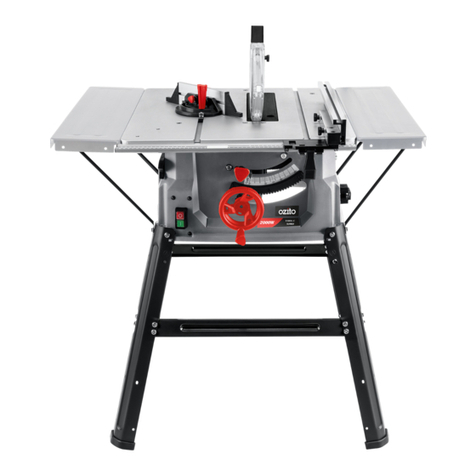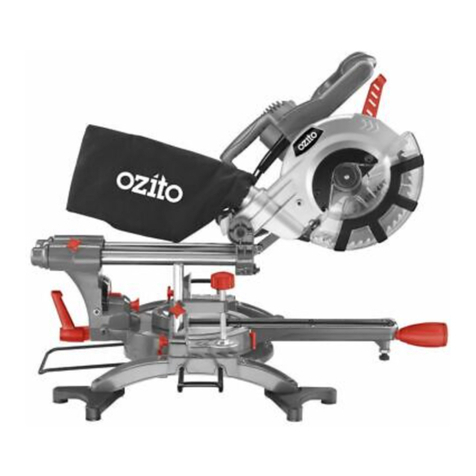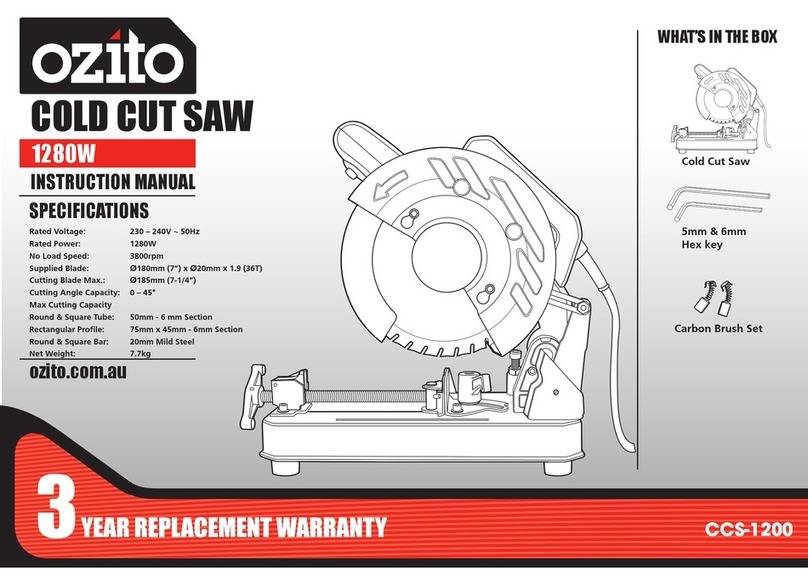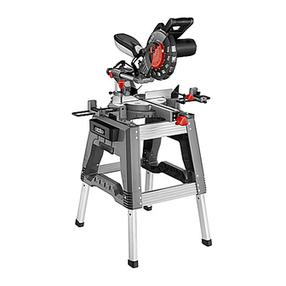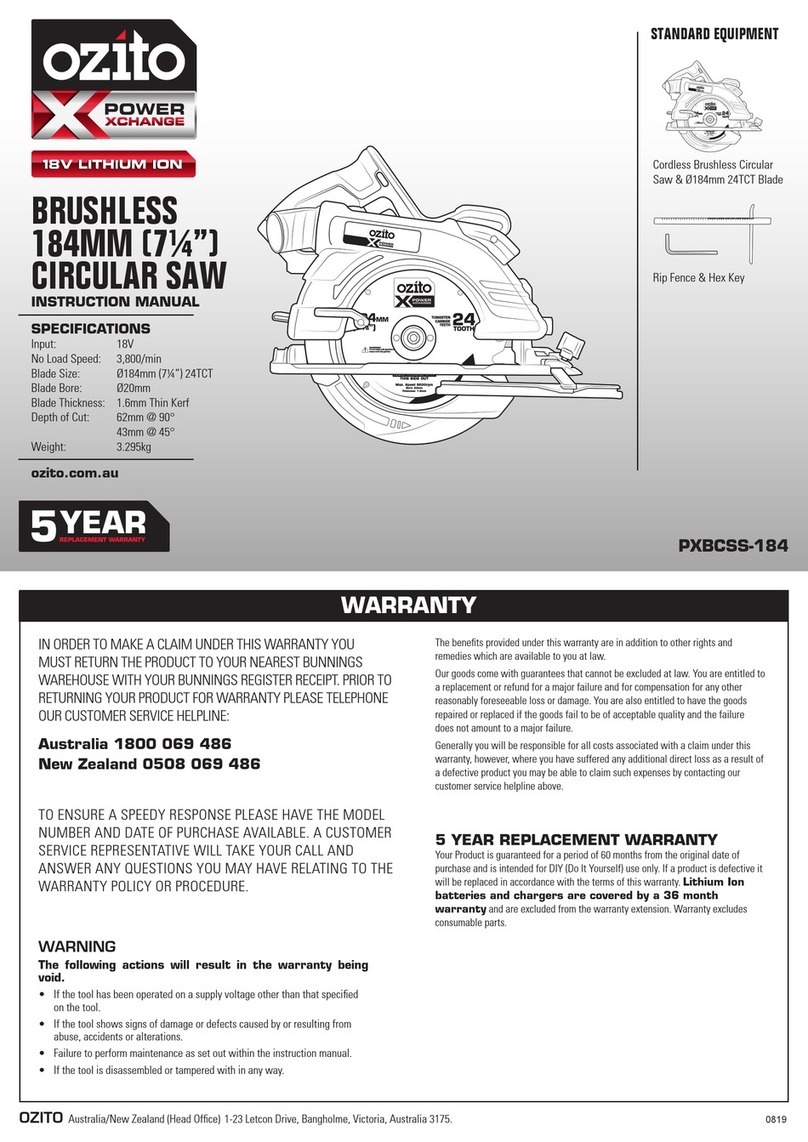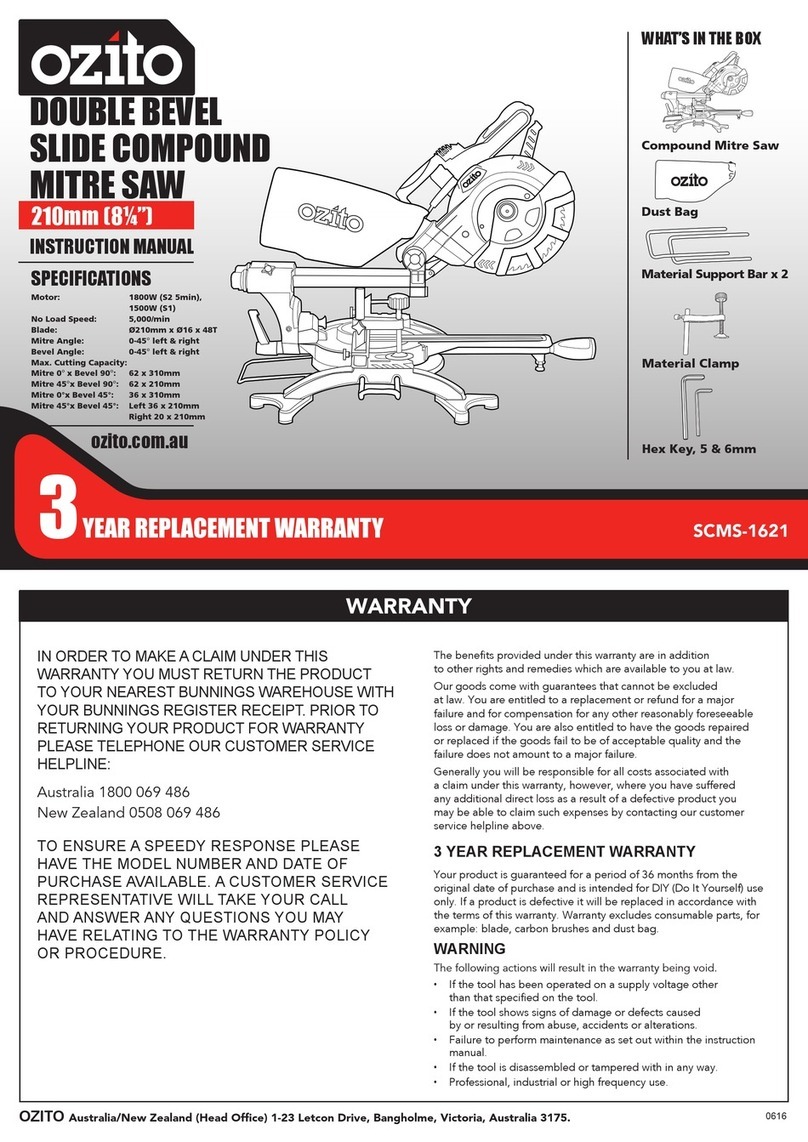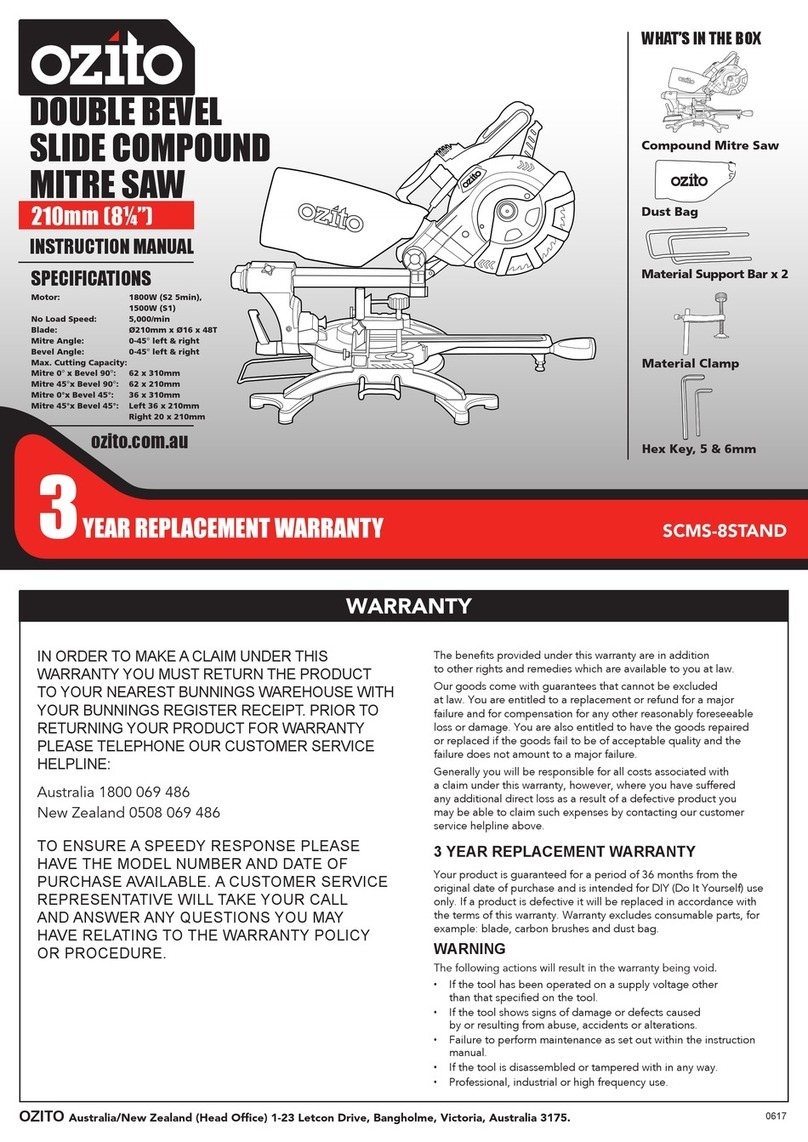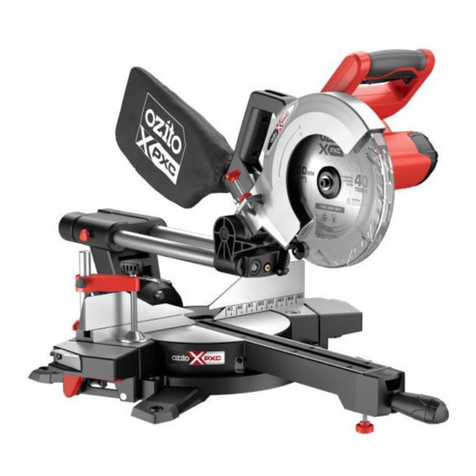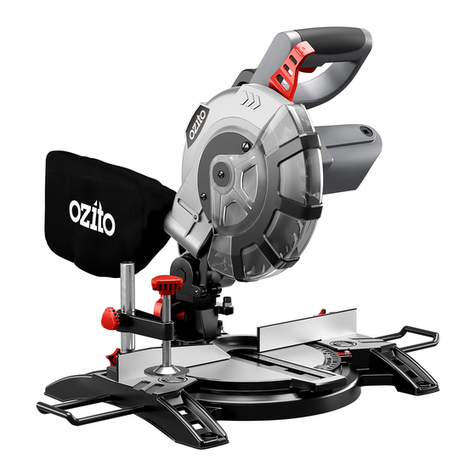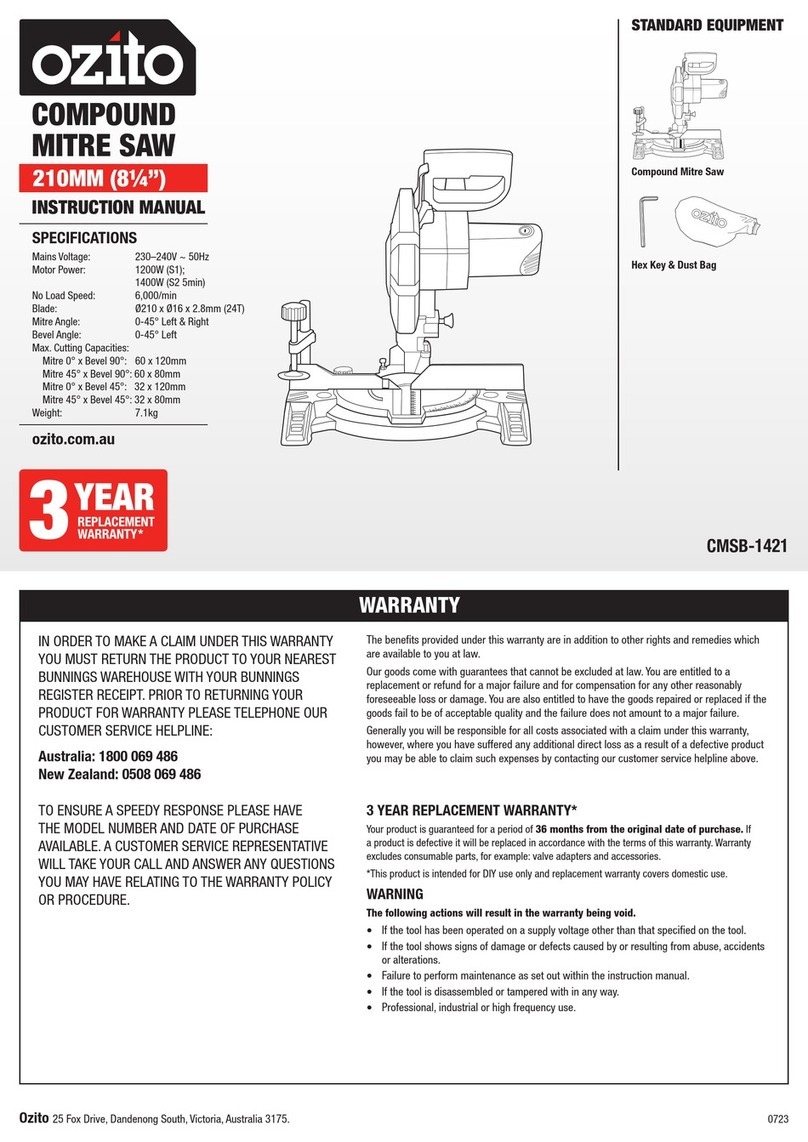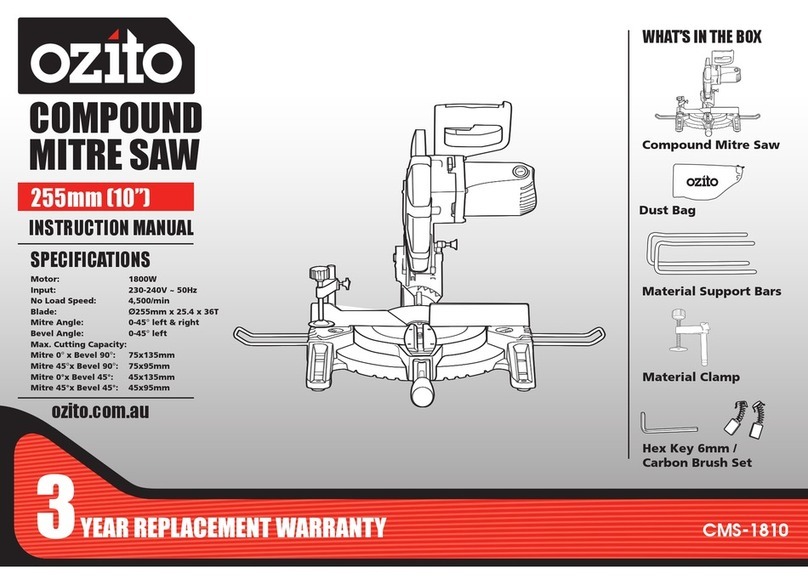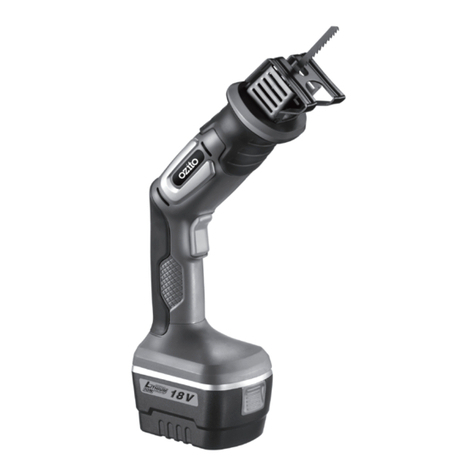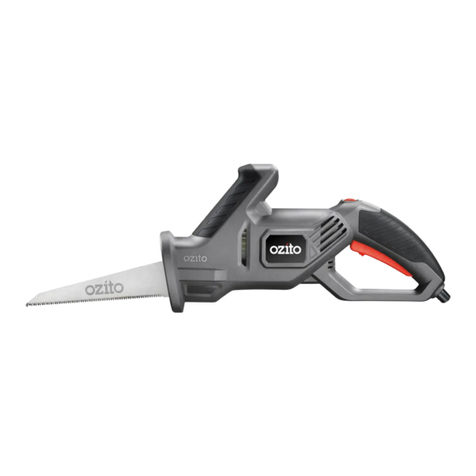1. Safety actions
• Blades that are deformed or cracked must not be used.
• If the table insert is worn, replace it.
• Use only blades which are recommended by the manufacturer and comply with
EN 847-1. When changing the blade, make sure that the cutting width is not smaller
and the saw plate not bigger than the thickness of the splitter.
• Make sure that the chosen blade is suitable for the material that is to be cut.
• If necessary, wear suitable personal protection equipment. This could consist of:
- Ear plugs to prevent the risk of damaging your hearing;
- A breathing mask to avoid the risk of inhaling hazardous dust.
- Always wear gloves when handling saw blades and rough materials. Whenever
practicable, saw blades must be carried in a container.
• The following can have an inuence on dust development:
- Worn, damaged or cracked saw blades
- Recommended capacity of the vacuum extraction system: 20 m/s
- Proper guidance of the workpiece • Blades made of high-alloy high-speed steel
(HSS) must not be used. • Keep the push stick or handle for a push
block at the machine at all times, even when you are not using them.
• When the push block is not being used, insert it into its holder.
2. Maintenance and service
• The following conditions can have an inuence on noise impact on the operator:
- Type of sawblade (e.g. saw blades designed to reduce noise development)
- Material of the workpiece
- The force with which the workpiece is pushed against the sawblade
• Faults on the machine or its guards, safety devices and blade must be reported to the
person in charge as soon as they are discovered.
3. Safe operation
• Use a push stick or the handle with a push block to feed the workpiece safely past the
saw blade.
• Use the splitter and set it correctly.
• Use the upper blade guard and set it to the correct position.
• Circular saws must not be used for slotting jobs (cutting grooves which end in the
workpiece).
• Use only blades whose permissible maximum speed is not lower than the maximum
spindle speed of the bench-type circular saw and of the material to be cut.
• Use only the transport devices to move the machine. Never use the guards for
handling or moving the machine.
• While you are moving the machine it is best to cover the top part of the blade, e.g.
with the guard.
• Secure long workpieces against falling off at the end of the cut (e.g. with a roller stand
etc.)
4. Additional instructions
• Give these safety regulations to all persons who work on the machine.
• Do not use this saw to cut re wood.
• Do not use this saw to cross-cut roundwood.
• Caution! Hands and ngers may be injured on the rotating saw blade.
• The machine is equipped with a safety switch to prevent it being switched on again
accidentally after a power failure.
• Before you use the machine for the rst time, check that the voltage marked on the
rating plate is the same as your mains voltage.
• If you need to use an extension cable, make sure its conductor cross-section is big
enough for the saw’s power consumption. Minimum cross-section: 1 mm².
• If you use a cable reel, the complete cable must be pulled off the reel.
• Check the power cable. Never use a faulty or damaged power cable.
• Operators have to be at least 18 years of age. Trainees of at least 16 years of age are
allowed to use the machine under supervision.
• Keep your workplace clean of wood scrap and any unnecessary objects.
• Persons working on the machine should not be distracted.
• Note the direction of rotation of the motor and saw blade.
• After you have switched off the motor, never slow down the saw blade by applying
pressure to its side.
• Only t blades which are well sharpened and have no cracks or deformations.
• Never dismantle the machine’s safety devices or render them inoperative.
• Faulty saw blades must be replaced immediately.
• Never use saw blades which do not comply with the data specied in this manual.
• It is imperative to make sure that all devices which cover the saw blade are in good
working order.
• Warning: It is prohibited to use this saw to make plunge cuts.
• Damaged or faulty safety devices have to be replaced immediately.
• The splitter is an important safety device. Not only does it guide the workpiece, it
also prevents the kerf closing behind the blade so that there is no kickback from the
workpiece. Note the thickness of the splitter. The splitter should never be thinner than
the saw blade body or thicker than the width of its kerf.
• The guard hood has to be lowered over the workpiece for each cut.
• Be sure to use a push stick when slitting narrow workpieces (smaller than 120 mm in
width).
• Never cut workpieces which are too small to hold securely in your hand.
• It is imperative for the parallel stop to be clamped on the right-hand side of the blade
whenever you cut narrow workpieces to size.
• Always stand to the side of the saw blade when working with the saw.
• Never load the machine so much that it cuts out.
• Always press the workpiece rmly against the saw table.
• Make sure that off-cuts do not catch on the saw blade crown. Risk of catapulting!
• Ret all guards and safety devices immediately after you have completed any repairs
or maintenance work.
• Be sure to observe the safety information and operating and maintenance instructions
issued by the manufacturer, as well as the dimensions listed in the Technical Data.
• It is imperative to observe the accident prevention regulations in force in your area as
well as all other generally recognized rules of safety.
• Note the information published by your professional associations.
• Connect up the dust extraction system on all jobs. The operator has to be informed
about the conditions with an inuence on dust development, e.g. the type of material
being processed (source and collection of the dust), the signicance of local separation
arrangements, and the correct setting of hoods, bafe plates and guides.
• Operate the saw only with a suitable vacuum extraction system or a standard
industrial vacuum cleaner.
• Never remove loose splinters, chips or jammed pieces of wood when the saw blade
is running.
• To rectify faults or remove jammed accessories, always switch off the machine rst.
Pull the power plug!
• To rectify faults or remove jammed pieces of wood, always switch off the machine
rst. Pull the power plug!
• If the sawing gap is worn, replace the table insert. Pull the power plug!
• This electric tool complies with the pertinent safety regulations.
• Keep your work area clean and tidy. Untidy and unlit work areas can result in
accidents.
• Keep the tool out of the rain and away from moisture. The ingress of water into an
electric tool increases the risk of an electric shock.
• Be careful, watch what you are doing and use an electric tool sensibly. Do not use the
tool if you are tired or under the inuence of drugs, alcohol or medication. A moment of
inattention when using the electric tool can result in serious injuries.
• Do not use an electric tool with a defective switch. An electric tool that cannot be
switched on or off is dangerous and must be repaired.
• Keep unused electric tools out of the reach of children. Do not allow people who are
not familiar with the tool or who have not read these instructions to use the tool. Electric
tools are dangerous if they are used by inexperienced people.
• Keep your cutting tools sharp and clean. Carefully maintained cutting tools with sharp
cutting edges will jam less and are easier to control.
• If the connection lead on the electric tool is damaged, it must be replaced by a
specially prepared connection lead available from our customer service organization.
• Have your tool repaired only by trained personnel using only genuine spare parts.
This will ensure that you tool maintains its safety standard.
• The machine has to be set up where it can stand securely.
• All covers and safety devices have to be properly tted before the machine is
switched on.
• It must be possible for the blade to run freely.
• When working with wood that has been processed before, watch out for foreign
bodies such as nails or screws etc.
• Before you actuate the On/Off switch, make sure that the saw blade is correctly tted
and that the machine’s moving parts run smoothly.
• Follow the instructions for lubrication and changing tools.
• Keep handles dry, clean and free from oil and grease.
• Keep the push stick or handle for a push block at the machine at all times, even when
you are not using them.
• Use only the transport device for transporting the machine.
• While you are moving the machine it is best to cover the top part of the blade, for
example using a guard.
Do not lose these safety instructions.
TSF-1211U
SPECIAL SAFETY INSTRUCTIONS
